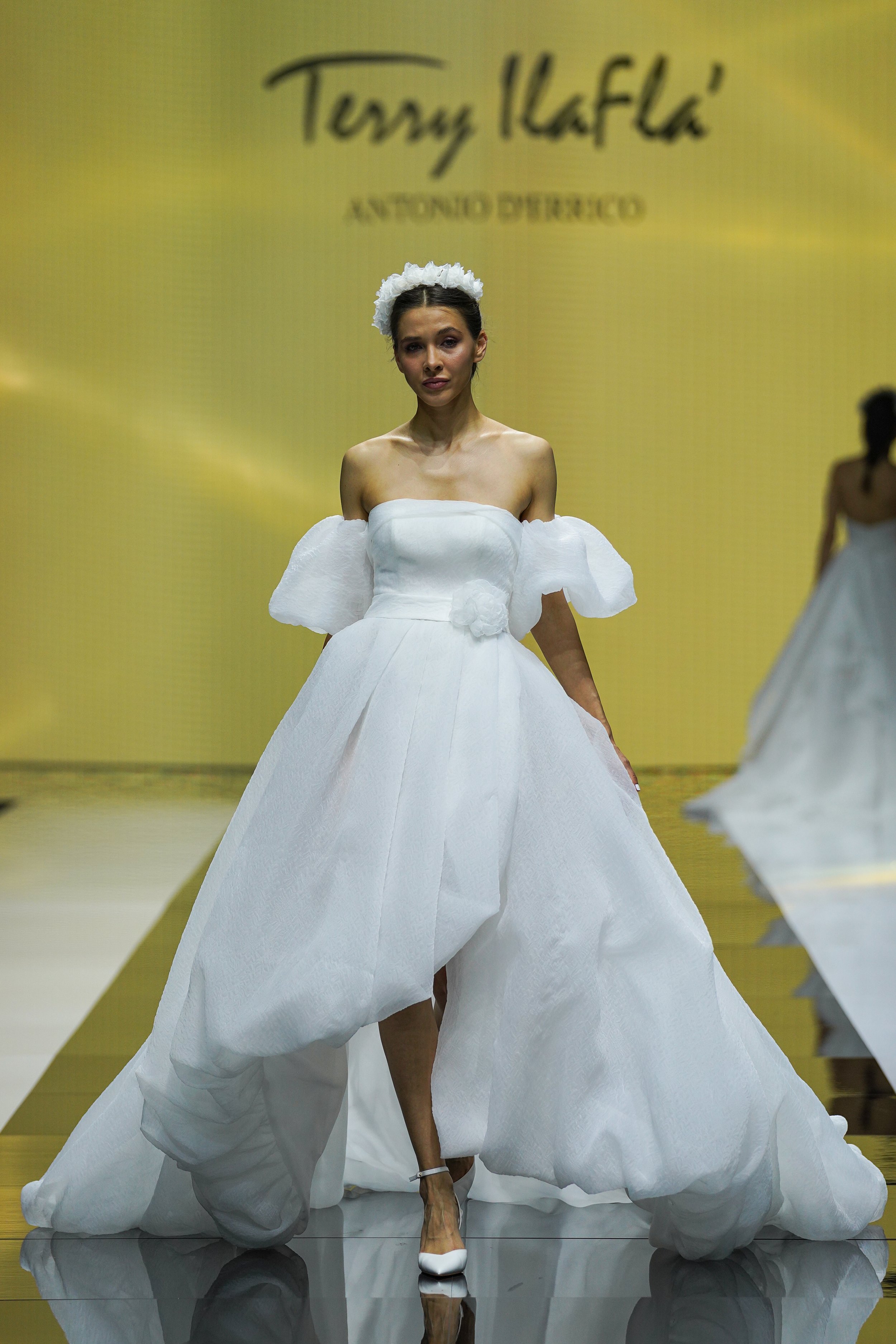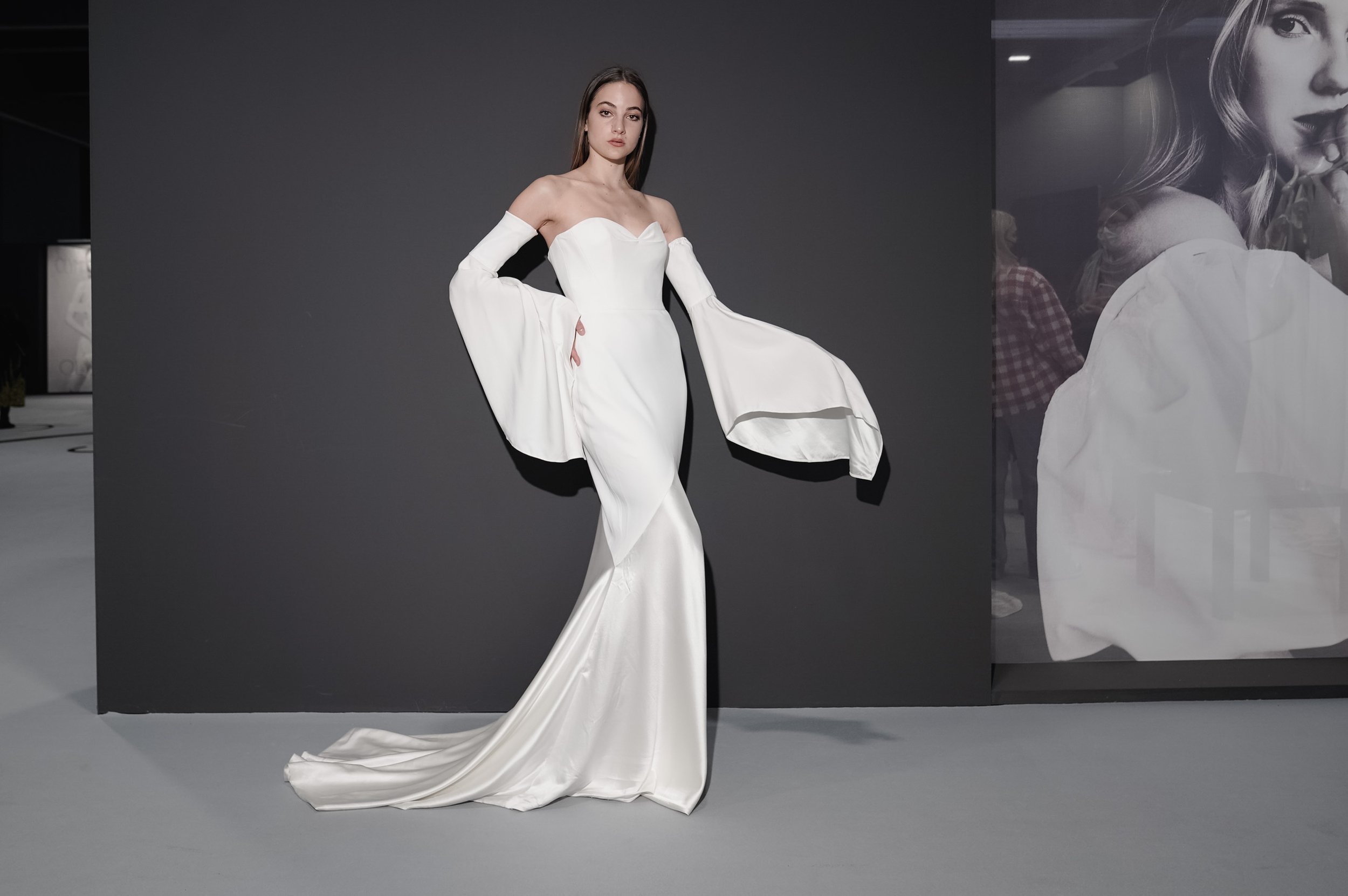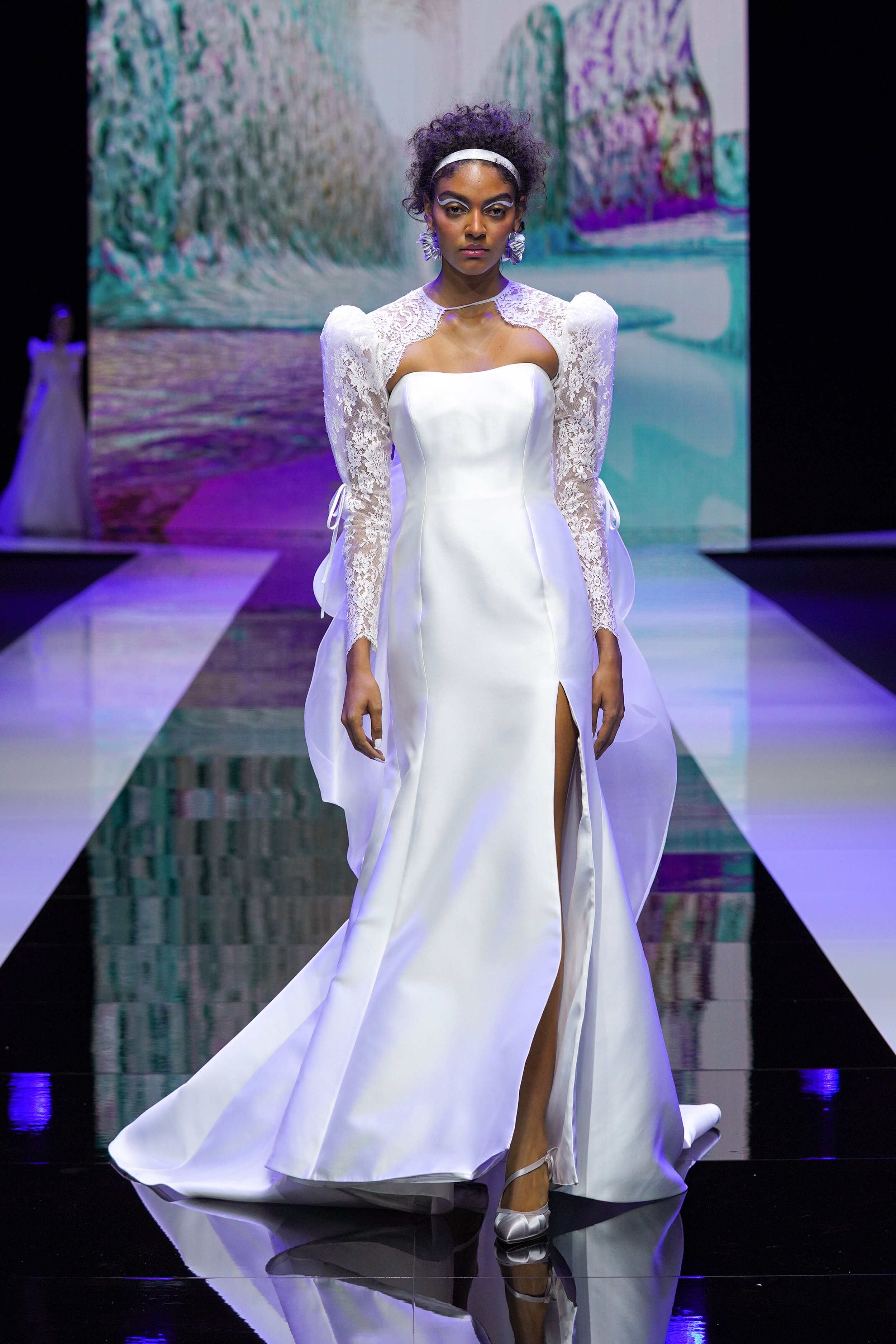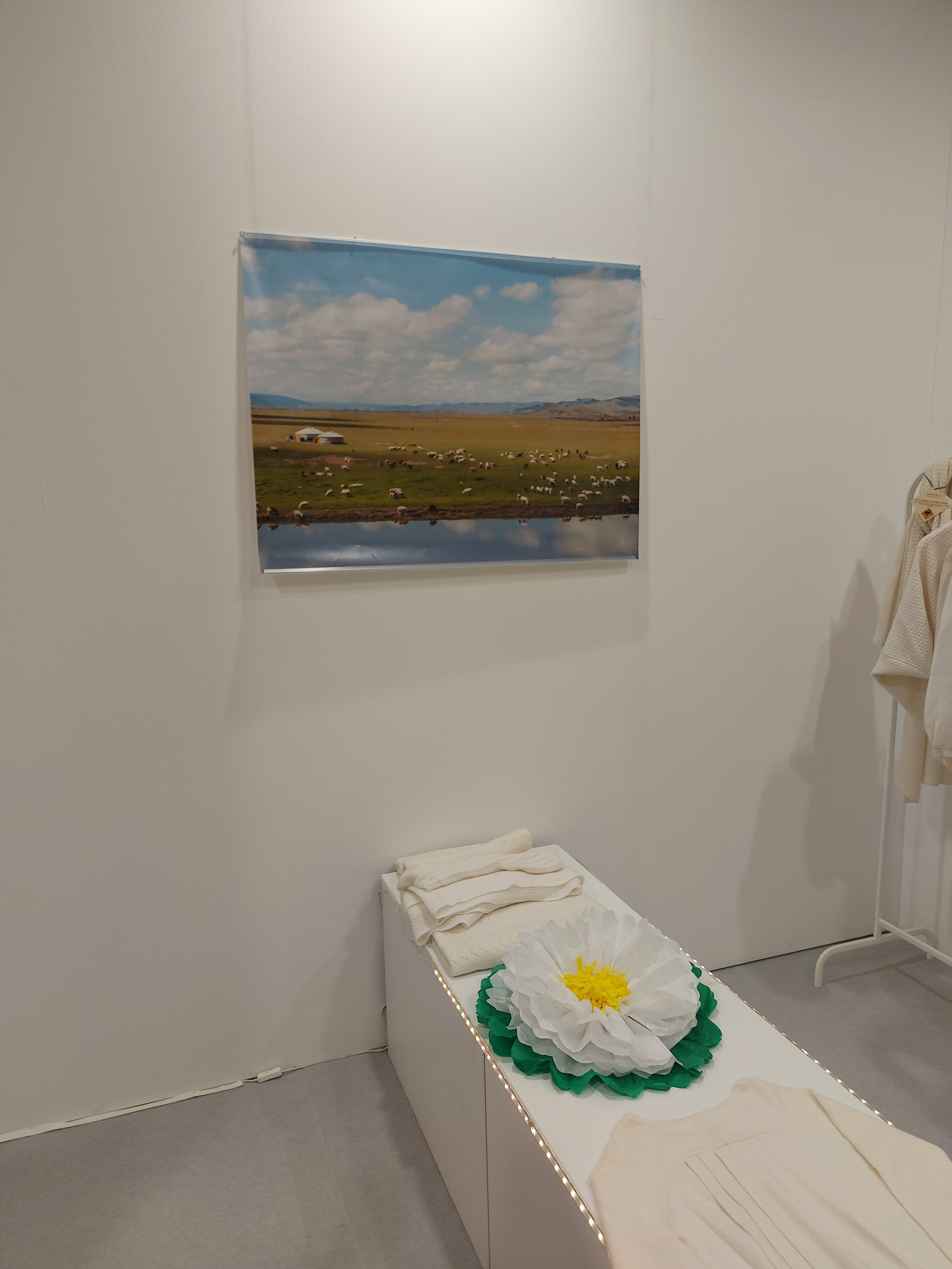Nice Day for a Ghost Wedding
Glamour and a Covid mask at the Enzo Miccio booth
In early April I was lucky enough to attend Sì Sposaitalia Collezioni 2022, the bridal fashion expo showcasing the latest in Made in Italy wedding attire. I must admit that I feel much more at ease in the half-empty-hotel-basement-conference-room settings of the academic symposium circuit, but I was determined to use this as a site of investigation for the theme of this issue, which is partnership. I came armed with research questions about what the European bridal system has to say about what it means to form an intimate partnership at the end of the world, yada yada yada—my typical killjoy stuff.
Determined to ask tough questions of bridal designers and their reps about sustainable practices, I found myself headed off at the pass by press materials about circular production and fully local supply chains. The official “Made in Italy” designation may not be completely airtight, but it’s a noble centralized effort and its defense is taken seriously; many exhibitors at the show proudly shared that their products are nose-to-tail Italian creations, and rightly frame this as a question of sustainability. [1] As these issues are increasingly important to people getting married, it seems like a smart marketing move to highlight this aspect of the Italian industry in particular. [2]
Exhibitors were much more reluctant to discuss Covid and the challenges faced by their businesses in the last two years, which is understandable. Like at so many indoor gatherings in this pandemic phase, it often felt at the show like everyone was looking over their shoulder, like, is it back? Is it going to see us acting normal and ruin it? But people do seem to be planning and holding weddings again, and I empathize with the desire to focus on joy.
“An increasing desire among couples for a “green” wedding has necessitated a response from the industry.”
On the one hand, for these designers and manufacturers, the show must go on. Restrictions are eased, people want to party, and brides still want gowns. But on the other hand, we can’t lose sight of the fact that post-pandemic economic recovery can’t just mean rushing to repair short-term losses. Shouldn’t we actually be trying to build a whole new system that can keep us on this planet in a functioning biosphere? This industry, which was hit harder than the fashion business generally (when you make ultra-special-occasion wear, it’s a lot harder to pivot to sweatsuits and WFH Zoom tops when your market evaporates overnight), is full of creative, passionate, skilled people who need to make a living and deserve an industry that can sustain them long-term; but how can they build that when their business relies on huge amounts of resources being poured into a single-use product?
And there’s the crux of the issue with the modern wedding gown: you’re only supposed to wear it once. The same tension between the short and long term that we face in the post-pandemic period ahead relates to the question that faces people getting married: how much energy are you supposed to put into this single day, this single outfit, compared to building a partnership that has a chance of lasting?
An increasing desire among couples for a “green” wedding has necessitated a response from the industry. According to the Sì Sposaitalia organization, there is more attention being paid to adaptability in recent seasons, supposedly enabling gowns to be re-worn. Having read this, I was on the lookout for the trend. Would an adaptable, rewearable wedding gown stand out in a sea of long, white, and uber-femme?
The Savin London booth caught my eye with a number of beautifully hand-painted chiffon gowns in florals that went beyond the white-cream-blush-champagne palette. The couture-level work and care that goes into a creation like that deserves more than one party, doesn’t it?
“This is the FSJ booth”
The Madame Seguin booth called to me with a large photo of goats grazing on a mountainside. Having recently read Emma Hague’s piece for this issue about the fibershed movement in the UK, this goat photo whispered to me, This is the FSJ booth. That intuition was confirmed in speaking to the owners, a married European couple attending the show from their home in Mongolia. Nearly ten years ago, when looking for a bridal cover-up for her sister to wear to her winter wedding, Klaartje Genbrugge found the answer in a cashmere stole purchased on a trip through Mongolia. Drawn to the place and the local cashmere producers, the couple left their jobs in banking and mining and relocated; Klaartje now designs a focused range of cardigans and wraps that are knit in small Mongolian factories, with yarn spun locally from sustainably farmed fibers, supporting the lifestyle of nomadic herders.
The knit pieces are soft, light, and elegant; the more fanciful ones are woven with shimmery Lurex from France and white turkey feathers (meat industry by-products) from Italy. The whole range is undyed, left its natural creamy off-white, making it an easy fit with bridal; they’ve also remained in this niche because the slower pace of change suits their smaller production capacity. As I got increasingly excited about the togetherness forged by this one small company—between herders, spinners, knitters, and brides half a world away—Klaartje mentioned that of course, these garments aren’t meant to be worn only once. The tagline for Madame Seguin is ‘for your wedding day and ever after.’ Were they trying to make me pass away?? “For instance, if you have a baby,” she said, “you might wrap the baby in the cashmere stole.” Listen, I’m crying just thinking about wrapping a baby in a soft shawl, so if there’s something to be picked apart there about the expectation of compulsory motherhood following marriage, I’m not the one who’s going to pick it.
I missed my family a lot on my trip to Milan, which helped keep me focused on the question of partnership. It was only because of my partner and some chosen-family friends that I was able to travel on short notice; otherwise my kids keep me pretty tethered to home. We’re 11 years and two kids into our marriage, and this is what partnership often looks like for us at this stage: keeping the ball in the air long enough to let the other do what they need to sustain themselves. It’s precious and we’re fortunate, but it turns out the legal contract and big party didn’t actually have much to do with it.
When getting ready for my wedding, I wrote my first piece for FSJ about which bridal traditions I liked and which ones I was ignoring, including wearing white. I wore red and navy and hot pink and gold and I pretty much thought I was liberating my generation by doing so. In the end, it really didn’t have the impact I expected. I know you think I’m a huge bridal influencer, but actually no one copied me.
I asked everyone I spoke to at Sì Sposaitalia about the demand for colorful gowns. They all said it was negligible. Just last week the New York Times called it a trend, but in the Italian sphere at least, it’s barely a blip. According to the exhibition’s 2020 press materials, the white wedding dress is actually spreading further and wider across the world than ever before, finding a place in the markets of even those countries with the most colorful of wedding traditions like India and China. Apparently, brides are using multi-day celebrations to cover lots of style territory, posing for photos in white gowns before changing for their ceremonies and receptions. [3] This is good news for the Italian bridal industry, yes, but we should probably question what’s behind the tenaciousness of this look.



Indeed, despite the occasional spot of pattern or color as in the Savin London booth, the overwhelming feeling at the bridal show was of the supreme dominance of the traditional white gown. And in the scary real world I keep harping on—Covid, war, climate collapse—isn’t it natural to retreat to the perceived safety of the past? [4]
Look, I recognize there are good things about traditions, sartorial and otherwise. There is beauty in being connected to our forebears even through something as basic as a color. We wear white because our mothers and grandmothers and great-grandmothers wore white. But most of us, even the luckier ones, don’t come from some unbroken line of the kinds of happy, egalitarian marriages we’d like for ourselves. So what are we actually invoking with this repetition?
One adaptability measure pointed out to me repeatedly at the show was detachable sleeves. Some were belled sleeves in intricate lace, others were puffy organza, some attached at or just off the shoulder, others floated freely like inflatable flutter wings, cinched at the upper arm and the wrist. The idea is that these can be worn for the ceremony and removed for the reception, creating the illusion of two distinct gowns, responding to the increasing desire for entire separate looks for the ceremony and the reception (everyone wants to make that second grand entrance like Meghan Markle in the Stella McCartney!).
I asked Cynthia Cooper, curator of dress, fashion, and textiles at the McCord Museum in Montreal about existing examples of gowns with detachable adaptations in the museum’s collection and she confirmed for me that the practice was widespread in the 19th century. Perceived less as a sacred garment meant for one occasion than as a send-off into a new phase of life, the wedding gown was intended to be worn for some time after the wedding and might be modified (with an evening bodice, for instance, or embellished trim, or indeed detachable sleeves) to suit various purposes as they came up in her early marriage. [5][6]
“Isn’t there something a bit weird about a trend from the heart of the imperial century now spreading deeper and wider into parts of the world still scarred by colonial violence?”
As we know, many of these 19th century wedding dresses would have been made in colors other than white, as it wasn’t until the marriage of Queen Victoria that the white gown (a laundry flex more than a purity flex, as it happens) started to snowball towards ubiquity. Of course, the colored wedding dress never actually died out completely, not even in the West; it’s not like Victoria killed it with one blow and the next white bride to wear red was me. There has always been a parallel history running alongside the official one, with its own share of cultural meanings. But something about that moment in 1840 when Victoria married her first cousin has proven very sticky, and Western weddings are stuck in a loop that won’t let us leave it behind. Isn’t there something a bit weird about a trend from the heart of the imperial century now spreading deeper and wider into parts of the world still scarred by colonial violence?
In fashion studies, I’ve always been most attracted to theories and methods like those in Caroline Evans’s Fashion at the Edge that resist linear historical narratives and make space for the time-looping effects of trauma. This way of looking at fashion also allows for the material realities of clothes, which persist through time, bringing all their memories with them, even once they cease to be visible as trends. History is spooky, after all, and the clothes and images that reappear from the past carry a lot of ghosts with them. I can’t think of a better example of this than wedding dresses. Imbued with all the hopes and expectations of a singular day, they stay in closets and basements for decades before someone pulls them out and—best case scenario—reworks them to be fashionable in the present.
Looking at fashion history as full of ghosts isn’t just for the sake of being macabre; the purpose is to uncover what the lasting traces of the past tell us about the present. So these white dresses carry the ghosts of rigid hierarchies and sexual shame (everything we think of as “Victorian”) along with whatever other meanings they’ve picked up along the way. But also, these “new” detachable sleeves bear the trace of a past in which gowns were sensibly re-used, even if they’re now just being worn for two events on the same day and then never again. What can we learn from seeing these dresses as ghosts of the 19th century? Is our desire for them some urge to return to a primal wound, or are we seeing the legacy of simpler, more sustainable weddings starting to poke through?
Ghosts! Ghosts! Ghosts!
Evans actually suggests that the continual backwards pull of the 19th century is logical, as modern fashion “sits on the bedrock of nineteenth-century commercial relations, urbanization and technological developments, and the impact of these upon sensibilities”; for this reason, contemporary fashion still speaks of that time, as much as the specifics might have changed. [7] And when it comes to wedding attire, even the specifics haven’t changed all that much. The Victorian era’s expansion of capitalism and commodification simultaneously destabilized symbolic and cultural meanings and, in reaction, tried to lock down the social order according to gender, race, and other clever illusions.
If we’re looking for clues to the present in the visual rehashing of the past, it seems obvious to suggest that the instability of our own time is what causes us to look backwards. Are we so freaked out by minimally expanding symbolic freedoms that we run back to corsets and petticoats in an attempt to make gender make sense again? Why are we so afraid of liberation?
There are, of course, people who can and do subvert and re-cast the symbols of the white wedding in liberated ways. Anyone who grew up othered, whose identity/ies were relegated to the bottom of old hierarchies, can step into a white gown and invoke the ghosts without inviting in the harm they cause. If you grew up without the culture reinforcing your beauty and inherent value as a partner, with images of brides as exclusively white, cishet, thin, and not you, then the riches of the wedding dream should be yours! It’s like saying, hey, Queen Victoria! Look who’s in your dress now, bitch!
But what might it look like to return to the vision of wedding, and gown, as a sending-off into the first phase of a partnership? What outfits would people choose to get married in now if the expectation was that those clothes would accompany them to significant parties and big moments over the next few years? Could the bridal business innovate and adapt to this vision while still fulfilling people’s desire for beauty and specialness? I don’t think it’s wise to try to fight the ghosts (they come with us into our marriages whether we like it or not), but we can choose which ones we invite to the party.
Notes
[1] “The Law of Labeling: What do “Made in” Labels Really Mean?” The Fashion Law, June 22, 2017, https://www.thefashionlaw.com/the-law-of-labeling-what-brands-need-to-know/#:~:text=stage%20of%20manufacture.%E2%80%9D-,Italy,components%2C%20design%2C%20the%20works
[2] Sì Sposaitalia Collezioni. “Green Wedding for the Gen Z.” Press release, February 2022. https://sposaitaliacollezioni.fieramilano.it/content/dam/man-sposaitalia/press/comunicati-stampa/2022/2.UK%20sposaitali%20webinar%20gen%20z.pdf
[3] Sì Sposaitalia Collezioni. “The Wedding Dress Worldwide, a Mix of Globalisation and Tradition.” Press release, June 2022. http://sposaitaliacollezioni.fieramilano.it/content/dam/man-sposaitalia/press/comunicati-stampa/S%C3%AC%20Sposaitalia%20Collezioni_3-EN.pdf
[4] The past was never safe for everyone, but we’re getting to that!
[5] Cynthia Cooper, email to author, April 11, 2022
[6] Victoria and Albert Museum, “Wedding Dress 1820-1824,” accessed April 11, 2022. https://collections.vam.ac.uk/item/O63393/wedding-dress-unknown/
[7] Caroline Evans, Fashion at the Edge (New Haven: Yale University Press, 2007), 9.





